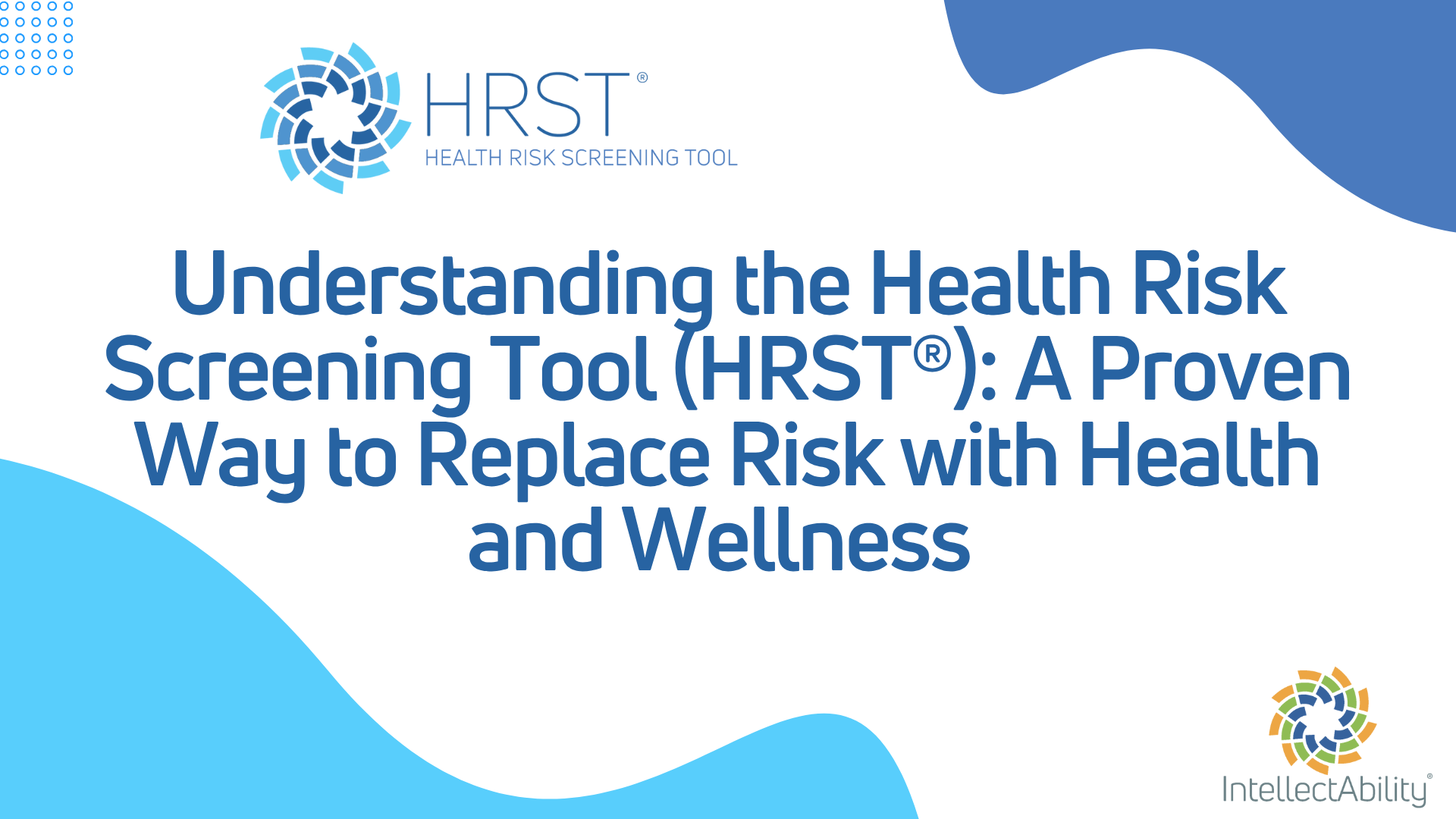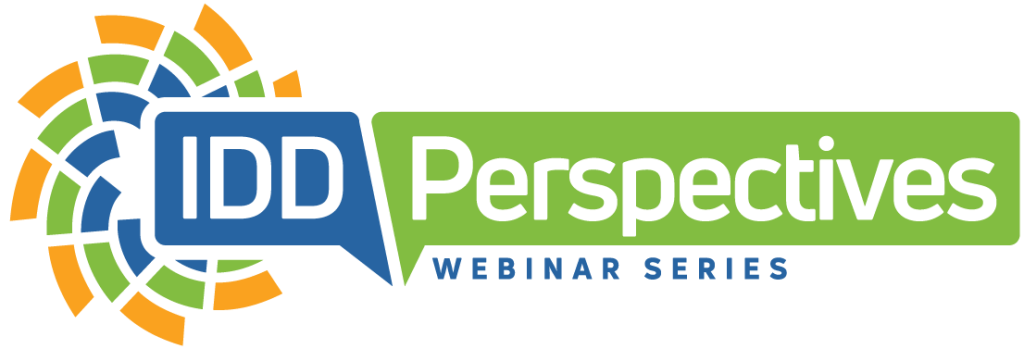
Understanding the Health Risk Screening Tool (HRST®): A Proven Way to Replace Risk with Health and Wellness
By Aliah Farley
Every day, people with intellectual and developmental disabilities (IDD) face health risks that often go unnoticed until it’s too late. These health risks affect individuals with IDD, who may require specialized support and monitoring. Many intellectual and developmental disabilities are present at birth or become apparent in early childhood, meaning these conditions are often observable from the very beginning of life. These unrecognized risks can lead to unnecessary suffering, hospitalization, and even preventable deaths.
The Health Risk Screening Tool (HRST), developed by IntellectAbility, was designed to change that reality by helping supporters identify and mitigate health risks early, ensuring individuals receive the right care at the right time.
What Is the HRST?
The HRST is a validated, field-tested, and HIPAA-compliant web-based tool that helps detect health destabilization in people with IDD and other at-risk populations. The HRST can be used on-site at provider locations, offering convenient health risk assessments for individuals where they receive services. Accessible 24/7, it equips supporters—ranging from direct support professionals to nurses and case managers—with actionable health information that improves outcomes and enhances person-centered planning.
Unlike static documentation systems, the HRST evolves with the person as they move through life, and it is recommended that an HRST screening be completed annually or after an episode, such as a fall or seizure. Organizations can customize the HRST to fit their specific needs and integrate it with other electronic systems for seamless data import and export. As Dr. Craig Escudé, President of IntellectAbility, describes it:
“The HRST goes far beyond routine documentation software. It evolves with the person as they travel through life. It is a living, breathing, person-centered health risk tool that provides actionable steps that save lives.”
How the HRST Works
Using a simple 22-item scale, the HRST assesses risks across various categories, including physical, behavioral, and medical. It also assesses functions such as cognitive, sensory, and physical abilities. Each question is answered objectively with “Yes” or “No” responses. These responses generate a score that determines a person’s Health Care Level (HCL)—with a range from 1 (lowest risk) to 6 (highest risk). The result of the HRST assessment determines the appropriate Health Care Level.
This level then automatically generates Service and Training Considerations, providing clear, specific guidance to the support team on the actions to take to mitigate health risks.
For example:
- Service Considerations might suggest a physician evaluation or medication review.
- Training Considerations direct staff on specific ways to support the person in their daily life to promote safety and wellness.
The HRST not only identifies risk. It empowers teams to take action.
Who Benefits from the HRST?
The HRST supports multiple levels of the IDD service system, including:
- People with IDD – by identifying often-missed health risks and underlying health conditions before they become emergencies. The HRST is especially valuable for children with developmental disabilities, as early identification can improve outcomes.
- IDD Provider Agencies – by informing person-centered plans and supporting continuity of care amid staff turnover.
- Managed Care Organizations (MCOs) – through improved care coordination, reduced hospitalizations, and better oversight of health and safety.
- State IDD and Medicaid Administrators – by offering a reliable, scalable, data-driven approach to health risk management and quality reporting, often eligible for Medicaid match funding through MAC or waiver billing.
Even two people with the same condition may be affected differently by health risks, highlighting the importance of individualized assessment and support.
Over 130,000 people are currently monitored using the HRST across more than 2,000 provider agencies and 20 states.
Evidence-Based and Predictive
The HRST’s reliability is backed by decades of research. It is important for users to understand the predictive value of the HRST when interpreting its results.
A study published in the Journal of Nursing Measurement (Vol. 28, No. 1) confirmed that the HRST’s Health Care Levels are predictive of mortality, meaning that as a person’s HCL increases, so does their risk of death. Researchers have validated the HRST through multiple studies, including additional long-term studies by the Center for Outcome Analysis, which further validated that the HRST can serve as a basis for determining healthcare needs and nursing acuity.
Annual mortality reports, such as those from the Georgia Department of Behavioral Health and Developmental Disabilities, continue to show a statistically significant correlation between HRST scores and mortality trends, demonstrating that early detection truly saves lives.
Integrated, Person-Centered, and Customizable
The HRST is designed to fit seamlessly into existing systems. It integrates with other platforms, such as ImpruvonHealth, to share key data, like demographics, medications, and diagnoses. It can also connect directly to telemedicine providers, such as StationMD, providing clinicians with immediate access to essential health risk data collected during each telemedicine visit.
More importantly, the HRST is deeply person-centered. It helps teams balance the “important to” and “important for” aspects of planning, ensuring that both wellness and personal preferences remain at the heart of every decision. This alignment supports compliance with CMS person-centered planning requirements under the HCBS Final Rule.
The HRST is a comprehensive program that offers a range of services to support individuals with IDD. These services include health risk assessments, personalized care planning, and accommodations to promote full participation and well-being.
Adjacent Uses of HRST Data
Beyond screening and planning, HRST data can be used to:
- Support mortality reporting and state performance measurement, ensuring alignment with policies that guide reporting and compliance
- Inform training initiatives for support staff, including education and ongoing learning opportunities
- Guide rate setting and budget allocation within Medicaid programs
- Monitor continuity of care during staff transitions
- Provide data for incident management, Level of Care (LOC) determinations, and medical home health eligibility
HRST data can also help improve health outcomes in communities by identifying conditions that influence health and participation.
Proven Impact, Real Lives Changed
From state-level agencies to individual providers, the HRST has become an essential part of proactive health management. The HRST helps identify problems, such as difficulties with hearing or cognitive functions related to the brain, as well as health risks affecting the body. As one nurse shared:
“Not only did the HRST accurately screen health risks, but it also assisted with identifying health issues that needed further evaluations.” – D.A., RNC, NP
And another put it simply:
“People are alive today because of the HRST.” – M.W., RN
Affordable, Scalable, and Supported
HRST licensing is offered on a per-person pricing model, making it accessible for organizations of all sizes. With scalable options and eligibility for Medicaid match funding, the HRST delivers high value at a low cost—providing organizations with a 24/7, data-driven tool that directly improves health and wellness outcomes. The HRST supports prevention by identifying health risks early, enabling organizations to take proactive steps and avoid potential health issues. This tool is also helpful for organizations seeking to improve health outcomes for the people they serve.
For more information and additional resources, see the following links provided in the next section.
Additional Resources
- To learn more about the adjacent uses of the HRST, download IntellectAbility’s “Utilizing the Health Risk Screening Tool to Improve Health Equity for People with IDD” white paper.
- To discover how to optimize HCBS and Healthcare Spending with the HRST, download IntellectAbility’s “Optimizing HCBS & Healthcare Spending for People with IDD During Medicaid Cuts” white paper.
- To review the Journal of Nursing Measurement study concluding that the HRST’s Health Care Level (HCLs) are predictive of mortality, download a copy.
- To see the impact of the HRST in Ohio, download the Ohio Department of Developmental Disabilities Evaluation.
- To learn more about how the HRST supports Person-Centered Planning, download IntellectAbility’s Promoting the Balance Between Risk and Personal Choice article.
Take the Next Step Toward Safer, Healthier Lives
The HRST continues to help states, providers, and managed care organizations replace risk with health and wellness for the people they support.
📞 Contact IntellectAbility today for a free demonstration.
🌐 ReplacingRisk.com
📧 Inquiries@ReplacingRisk.com
📱 727.437.3201




